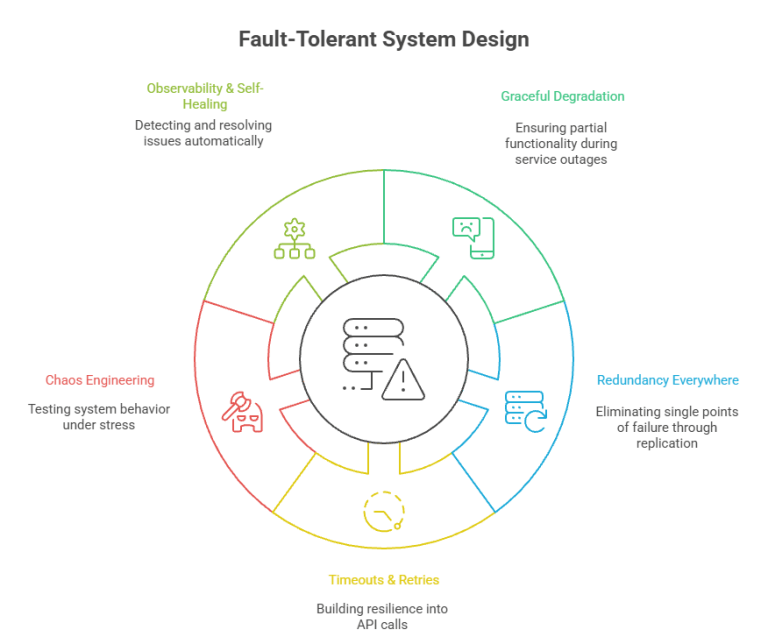Designing for Failure: Building Fault-Tolerant Systems in 2025

In a world where digital systems power everything from payments to healthcare, failure isn’t just possible—it’s inevitable. Outages, bugs, and unexpected behavior will happen. The real question is: how prepared is your system when it does?
That’s why the most resilient organizations in 2025 aren’t just designing for success—they’re designing for failure.
Whether you’re scaling a SaaS platform or launching a data-driven product, fault tolerance is no longer a luxury. It’s a core design principle that ensures continuity, trust, and business survival.
Let’s explore how forward-thinking teams are embedding failure into their design thinking—and building systems that bounce back faster and stronger.
Why Fault Tolerance Is a Must-Have in 2025
System reliability has become a competitive advantage. Downtime costs money, damages reputation, and breaks customer trust.
But the tech landscape is only getting more complex:
Cloud-native architectures spread across multiple providers
Microservices talking to each other in real-time
AI models introducing new unpredictabilities
Global user bases expecting zero downtime
The result? More points of failure. More unknowns. More risk.
Designing for failure means acknowledging these risks upfront—and engineering your systems to recover gracefully when things break.
What "Designing for Failure" Really Means
It’s not just about writing tests or setting up monitoring tools. It’s a mindset shift—one where every layer of your architecture is built with the assumption that:
Services will crash
Networks will go down
Dependencies will fail
Humans will make mistakes
When you embrace this, you stop asking “what if it fails?” and start asking “when it fails, what happens next?”
Principles of Fault-Tolerant System Design
Here are the key principles guiding fault-tolerant design in modern architectures:
1. Graceful Degradation
Ensure your app still works—partially—when certain services go down. Example: If your recommendation engine crashes, show a static fallback instead of breaking the page.
2. Redundancy Everywhere
No single points of failure. Use multi-zone, multi-region deployments. Replicate critical data. Design for failover.
3. Timeouts, Retries & Circuit Breakers
Build resilience into every API call. Don’t wait forever. Retry intelligently. Use circuit breakers to prevent cascading failures.
4. Chaos Engineering
Inject failure intentionally (yes, really) to test system behavior under stress. Tools like Chaos Monkey or Gremlin make this a controlled practice.
5. Observability & Self-Healing
Use logs, metrics, and traces to detect issues fast. Combine with automation to trigger recovery actions—before users even notice.

Common Failure Scenarios (And How to Handle Them)
Failure Scenario | Fault-Tolerant Approach |
Database crash | Auto-failover to replicas, use read replicas for scaling |
Third-party API timeout | Fallback response, cached data, or queue retry |
Deployment error | Use canary releases or blue-green deployments |
Service overload | Auto-scale, queue requests, throttle gracefully |
Human error | Implement role-based access, version control, approval workflows |
How Startups Can Start Designing for Failure
You don’t need a massive SRE team or million-dollar budget. Start small, iterate fast:
✅ Audit your current architecture: Identify critical dependencies and single points of failure.
✅ Set SLAs and SLOs: Know what “acceptable” downtime looks like—and design to stay under it.
✅ Automate recovery where possible: From container restarts to serverless fallback flows.
✅ Test under failure conditions: Simulate outages during staging. Run game days with your team.
✅ Train for incident response: Have runbooks ready. Practice with mock incidents. Speed matters.
The Techrover™ Philosophy: Resilience by Design
At Techrover™, we work with fast-growing startups to not just build fast—but build reliably. Our approach to resilient systems is simple:
Resilience Engineering baked into product design
Cloud-Native Patterns like retries, queues, fallback services
Chaos Testing to expose unknown failure paths
Observability Pipelines to catch and resolve issues before users do
Whether you’re building your first product or scaling globally, fault-tolerant design is what separates temporary success from lasting impact.
In 2025, Uptime Is Strategy
Designing for failure isn’t about expecting the worst—it’s about planning for the inevitable and recovering like a pro.
Because in 2025, customers won’t just compare features—they’ll compare experiences. Reliability is the new UX.
And the startups that win? They won’t just move fast. They’ll move resiliently.
Ready to Build Resilient Systems?
At Techrover™, we help engineering teams design, test, and launch systems that can survive failure—and thrive through it. From cloud architecture audits to chaos testing playbooks, we bring resilience to your roadmap.
Let’s make failure just another design requirement.


